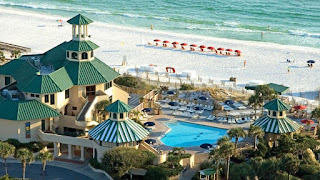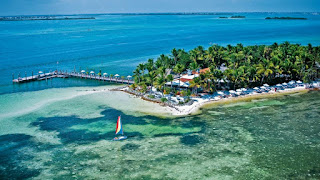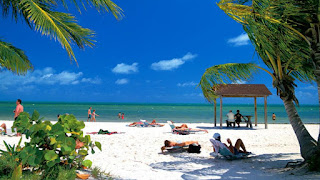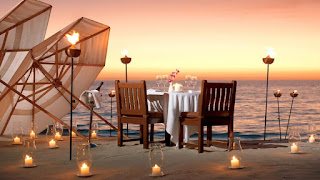10 Adventures You Can Have in Costa Rica.
With zip lines, curious monkeys, beaches
fringed by tropical jungles and sustainable Eco-adventure, Costa Rica delivers on its promise of Pura Vida “pure life” – a mantra that’s a way of life here. Bonus: There’s no jet lag (it’s the same time zone as the Midwest) and there are nonstop flights from 15 U.S. cities.
1. Take Flight
If you spend any time in Costa Rica and
don’t go on a zip line , you’ve kind of
missed the point of a trip here. The
bravest go “Superman” on their belly, head first. Zip lines aren’t hard to find —
whether it’s in the misty cloud forest of
Monteverdi, in the looming shadow of the Arenal volcano, or through the colorful jungle canopy at various spots throughout the country.
2. Walk on the Wild Side
More than 25% of the country is protected land or national parks. Bird-watchers should put Los Quetzales National Park (south of San Jose) on their itinerary to see the resplendent quetzal (really, that’s the bird’s name) and many other birds that call the cooler climes of the cloud forest home.
As for the monkeys, these guys are everywhere, and you might actually hear them before you see them. Howler monkeys are Costa Rica’s version of white noise — a soundtrack to remind you that you aren’t in the States. Capuchin monkeys will pop their white heads out of the trees to see what’s going on and may photo bomb your next selfie.
Corcovado National Park on the country’s southern Pacific coast is the country’s largest national park, and home to 3% of the world’s biodiversity all by itself. The waters off the surrounding Osa Peninsula are a great spot for dolphin sightings and whale-watching — humpback whales come to the waters off of Caño Island from as
far away as Alaska.
3. Surf Both Coasts
Year-round surfing on the Pacific and
Caribbean Coasts has drawn ex-pats to
Costa Rica, and built up surf towns along
the way. Jaco is the closest to San Jose,
but our Deal Experts recommend making your way to Guanacaste in the country’s northwest for the best experience. Flying directly into Liberia makes getting to there easier. No need to bring your own board — many beaches will have a small stand offering boards and lessons for ahalf day or more. Towns like Nosara, Samara, Avellanas and Tamarindo are among our favorites.
Serious surfers will make their way to
Puntarenas at the end of the Nicoya
Peninsula to the surf community at Santa Teresa Beach. If you’re really up for an adventure, head to Pavones in the
country’s far south for the three-minute
rides on the left-handed break.
4. Hike a Volcano
Towering like an ancient Mayan pyramid above the central Costa Rican forest, the Arenal volcano is one of the country’s iconic sights. While the volcano has been dormant since 2010, there’s still the occasional rumble in the jungle. The area around Arenal is a veritable playground with the massive Lake Arenal used for boating, kayaking and stand-up paddle boarding, hot springs and waterfalls (more on these later), zip lines and horseback riding. Get up early no matter when you go to try to sneak a peek at the peak — the volcano summit often hides behind the afternoon clouds.
Arenal is one of 5 “active” volcanoes in
Costa Rica scattered along country’s
mountainous interior. Poás and Irazú are a comfortable day trip from San Jose
(bring a jacket, it can get cold up top). On
a clear day, you can see both coasts from
the summit of Irazú. Rincon de La Vieja National Park’s focal point is a volcano that is over a million years old but has erupted as recently as 1991. Hike up to the top of the volcano for magnificent views of the Nicoya Peninsula and the Lago de Nicaragua. Or try other adventures here, including canyoneering,waterfall rappelling (you literally rappel down a waterfall) and, of course, zip-lining.
5. Relax in the Jungle
So how exactly is a spa day an adventure? When your hot tub is a naturally occurring hot spring, and your spa attendant may well be a curious monkey. Costa Rica’s volcanic underpinnings mean hot springs
bubble to the surface — drawing in
visitors looking to unwind in mineral
waterfalls amid a leafy backdrop.
6. Chase Waterfalls
It’s hard to beat the rush of that first
time you see (and hear) a waterfall
bursting from the jungle backdrop. There are several falls worth a detour —
especially during the green season, when
the rains feed Costa Rica’s rivers.
La Fortuna waterfall (near Arenal) is
about a 20-minute hike on a well-marked
path with a big reveal at the end. You can swim in the cold waters at the waterfall’s base or take the rope swing to jump in. Another favorite is in Tenorio Volcano National Park in the Northern Plains, where the Rio Celeste plunges out of the jungle into a pool of brilliant blue water.
7. Rafting on the Rio
Costa Rica’s Rios (for you gringos) are an
adventure all to themselves. Rio Pacuare is a white-water playground — we’re talking rapids as rough as Class V as the river rushes through gorges and untouched tropical forest toward the
Caribbean. National Geographic named this one of the top spots in the world for
white-water rafting. Companies will take
you out for everything from a fun-filled
day on Class III rapids to a 3- or 4-day
adventure with serious white-water
during the day and luxe eco-lodges at
night.
If tubing, whitewater rafting and rappelling are not your thing, try stand-
up paddle boarding on the Pacific Coast. The waters are calm at Peninsula Papagayo in Guanacaste, and you may spot a few folks balancing on their boards while practicing yoga. UNESCO just declared Costa Rica’s Savegre a Biosphere Reserve and rightfully so as it hosts 20 percent of Costa Rica’s flora, 54 percent of the country’s mammals and 59 percent of birds. The region’s focal point is the pristine Rio Savegre where daring visitors can not only see the tapirs, jaguars and a plethora of birds that line the river, but can do so while white-water rafting. Be sure to make a pit stop at the beautiful San Gerardo Waterfall aka Rio Savegre Waterfall, your reward for conquering the
rapids.
8. Hit the Road
Driving in Costa Rica can be its own
adventure. Take our advice and get the
4×4 rental when it’s offered, but also be
advised, no driving on the beach. While
main roads are generally okay, secondary and mountain roads can be narrow and rough — especially when rains cause potholes or washouts. Getting to off-the- beaten path gems requires a vehicle that can beat its own path. You should also get the GPS — road signs aren’t common outside the main cities, and even then it’s spotty. Don’t expect to get from Point A to Point B in record time, so embrace the slower pace. It’s worth a stop at a roadside shack for some rice, beans and plantains or a refrescos — a fresh fruit drink popular in Costa Rica. One of our favorite ways to get around in Costa Rica is via horseback, whether it’s climbing the hills around Arenal (so you can zip line down) or along the surf at Hermosa Beach or Manuel Antonio.
9. Take a Deep Dive
Costa Rica’s name in Spanish means “rich coast” — which has as much to do with the treasures below the surface as it does the picturesque beaches. The Gulf of Papagayo in Guanacaste is a popular (and accessible) spot for casual divers — one of many along the Pacific Coast. If you’re serious about scuba, then Caño Island and the waters near Corcovado National Park should be on your list. This is a trip in and of itself, but the deep sea diversity is something to write home about. We’re talking schools of fish so thick that they block the sun, plus manta rays, bull sharks, dolphins and more.
10. Stretch Out Your Vacation.
A little Zen goes a long way, and our Deal Experts really like to get their “Om” on in Costa Rica to balance out all the
activities. There are several yoga retreats scattered around the country — not surprising in a place where the natural surroundings are inherently peaceful. One favorite spot is Nosara, a beach front area on the Nicoya Peninsula that also doubles as a great surf spot. Ride the waves in the morning; strike a pose in the afternoon.
Sounds like the perfect day.


















































